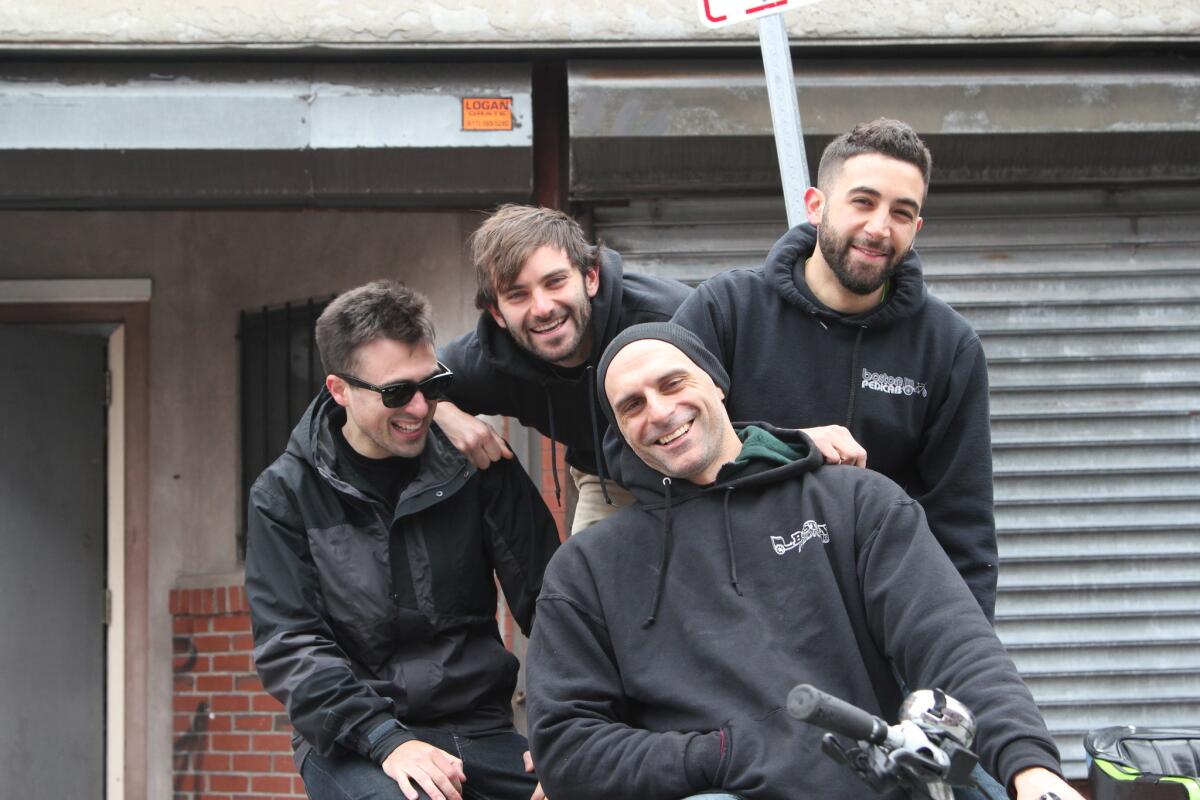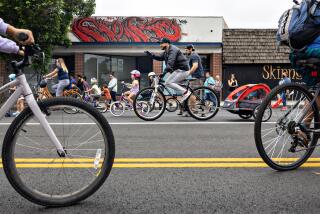Boston Marathon: Pedicab drivers gave emergency rides in 2013

BOSTON -- Shouts of “Want a ride?” and “Grown-up tricycle rides here” echo around this city as Pedicab drivers peddle their bike-meets-taxi transport.
That was true around Copley Square after last year’s devastating Boston Marathon bombings, which left three spectators dead and more than 260 wounded near the finish line.
Jesse Lyons had started at Pedicab full time about a week earlier.
“For about an hour afterward, people were still coming up from Fenway and they didn’t know,” Lyons, a Pedicab manager, said softly.
The drivers were the ones who told them.
“We told hundreds of people” about the bombings, Lyons told the Los Angeles Times. “Some people were in different states of inebriation; they didn’t get it. Other people thought we were lying. There were people in tears. I remember there was a guy next to me and he said, ‘I just saw an explosion, is this happening?’ And I said, ‘I saw it too, we are not dreaming, this is bad.’ ”
Boston is old, and so are its streets. It’s not like New York City, which is laid out on a grid, or Los Angeles, where frequent signs point people in the right direction. Some areas of Boston are still paved with cobblestones, and some streets -- so narrow that not even a Smart car can get through -- mainly serve pedestrians.
Those streets are why guys on bright green tricycles that can drive on sidewalks and narrow roads came in so handy April 15, 2013, at 2:49 p.m.
“The thing that always irked me was the perception of us as of jokers, weirdos, shysters and whatnot, and we’re the only thing that could move through the streets that day,” Christian Matyi told The Times while perched atop his trike in Boston’s South End.
Pedicab drivers went from silly sideshow to mobile emergency vehicles in an instant.
“Our bizarre set of skills, like improvising in a crowd, control a crowd, get information fast, be able to communicate … all of a sudden that become not only important but the only thing that was needed for 10 minutes,” Matyi said.
People in the neighborhoods around the bomb sites had to be told to stay away, and medical workers needed to get to the hospitals.
One of them was Dr. Jeffrey Kalish, director of endovascular surgery at Boston Medical Center.
Kalish and his 9-year-old daughter were snaking their way from the marathon’s starting line to the finish to watch his wife run across it. She was about 10 minutes away when the bombs went off.
Kalish found a friend to take care of his daughter, and his friend tried to drive him to the hospital. But the streets were so congested that Kalish decided it would be better to walk.
“I don’t even ... remember where I was, and I just started walking towards Boston Medical Center,” he told The Times.
Then Kalish spotted a group of Pedicab drivers congregating in the South End. Boston police had told them to stay off the roads, so the drivers headed back to their headquarters and opened the shop to anyone who needed a meeting point or a landline to call family.
“I remember just very distinctly,” Kalish said, “I walked up to the group of people and said, ‘Hi, my name is Jeff, I’m a surgeon at Boston Medical Center and I need to get there very quickly,’ and I remember [one of them] just said, ‘Let’s go.’ ”
“I think we exchanged names, that’s about it,” said the driver, Nicholas Viau.
And off they went. When they got to the hospital, Kalish said, “I asked if I could pay him and he said, ‘Absolutely not.’ ”
“Yeah, it was one of those days,” Viau said. “It’s on the house.”
“So I still owe him for a Pedicab ride,” Kalish said.
Until Kalish and Viau were interviewed together last week, they had not seen each other since that day.
Kalish had something more to tell his Pedicab driver: “Thank you very much. My patient that I operated on that day, he thanks you too. I’m not a very active sprinter, I’m not a very active physical person. So if I had actually run that mile and a half … I would not have been in the exact same shape that you provided, so thank you.”
Matyi, Viau, Lyons and Dylan Ramsey estimate they gave 10 rides like this to local hospitals.
Are they worried about Monday? Each one hesitated before answering.
“Anything can happen at any time, of course. The thought has crossed my mind,” Lyons said. “But we’ve got to keep living our lives. We can’t have that fear always.”
Twitter: @SLeasca
More to Read
Start your day right
Sign up for Essential California for news, features and recommendations from the L.A. Times and beyond in your inbox six days a week.
You may occasionally receive promotional content from the Los Angeles Times.







